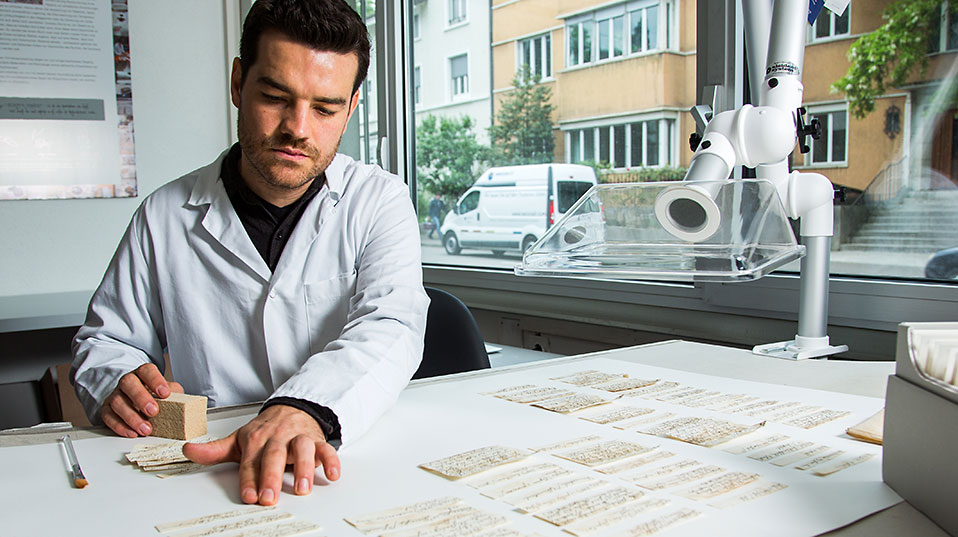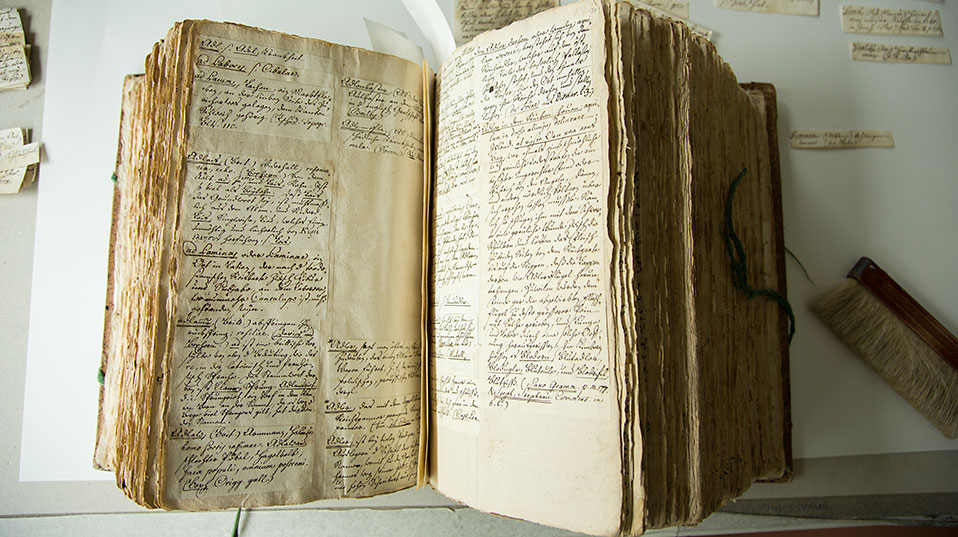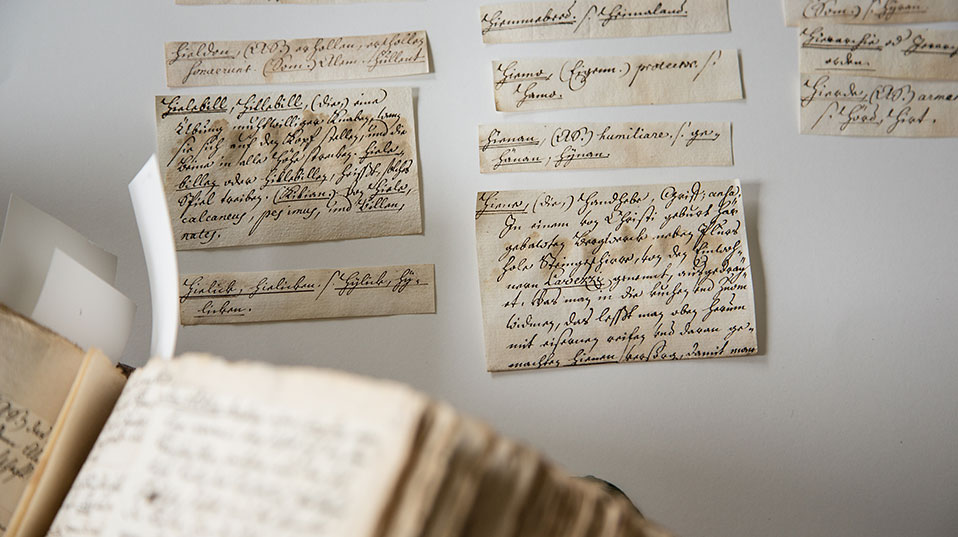Left unprinted for lack of interest: the largest German dictionary of the 18th century in Basel
For 250 years, the extensive set of manuscripts and papers lay unnoticed in the University Library’s basement. Now, linguists from the University of Basel are providing access to Johann Jakob Spreng’s Grosses Glossarium der deutschen Sprache (Great Glossary of the German Language) for the first time. With almost 100,000 entries, it would have been the largest German dictionary of its era – but not enough buyers were found to print it.
09 May 2018
Johann Jakob Spreng (1699–1768) compiled his handwritten dictionary from 1740 until his death 250 years ago this year. The dictionary comprises 20 volumes and a large box filled with 33,000 loose pieces of paper. The Basel-based professor had gone to huge efforts to collect this material for a historical/etymological dictionary, which he planned to have printed. With 95,000 entries, it would have been by far the biggest dictionary of the 18th century: Johann Christoph Adelung’s collection of terms, compiled in three volumes from 1774 to 1799, ran to just 50,000 entries. The dictionary planned in Basel would not be surpassed until 1854, when the Brothers Grimm – the well-known collectors of fairy tales – published their Deutsches Wörterbuch (The German Dictionary).
Fostering the German language
“If the most comprehensive dictionary of its time had been printed, it would have been a sensation,” says project leader Professor Heinrich Löffler, a retired linguist at the University of Basel, who brought the material to light. Glossaries of this kind were considered an important part of emerging efforts to foster German as a written language in order to replace Latin as the language of scholars. As was often the case during this period, Spreng was the sole author of the work and wrote all the entries himself.
However, the material initially went untouched. Along with the box of papers and notes, the volumes remained with Spreng’s descendants for almost 100 years. In 1862, the Department of Manuscripts at the University Library acquired the unbound collection. For a long time, it was reputed to be messy and incomplete; at first glance, the entries for ten volumes, or rather letters, appeared to be missing. It was only when the linguists laid out and organized the materials that they realized all the missing words were in the loose papers, albeit hidden in a muddled pile of over 1,000 small envelopes and covered by thick layers of dust.
“Hidden treasure”
Löffler had stumbled across the “hidden treasure” a few years ago. The linguist was conducting research related to the oldest dictionary of Basel German, the Idioticon Rauracum, which was also compiled by Spreng, a Basel native, and has now been in print since 2014.
The University Library has been working intensively for three years to clean and digitize all of the volumes and papers that make up the Glossarium. Löffler is working alongside colleagues and volunteers to transcribe the handwritten papers and convert them to a form suitable for printing. Around a third of the editing has been completed so far – in all, the dictionary will run to an estimated 4,500 pages, with a two-column layout, by the time of its planned completion in around three years.
According to Löffler, Spreng may have struggled to drum up sufficient interest in his dictionary at the time because he worked at the university as an unsalaried associate professor – initially of German rhetoric and poetry and later of Swiss history and Greek – and was thus seen as an outsider. Moreover, the new form of German had not yet gained widespread acceptance as a standard language, and certainly not as a language of science: “Spreng was decades ahead of his time.”
The scholar suffered constant financial difficulties, earning his living as a minister in an orphanage until his death. In addition, the year 1763 saw him mired in scandal and facing a publication ban for having allegedly spoken in a frivolous tone about legends of Catholic saints.
An exhibition of his life and works
To mark this year’s 250th anniversary of Spreng’s death, the University Library Basel is organizing an exhibition entitled “Ein sprachlicher Jahrhundertschatz wird gehoben” (Highlighting the linguistic treasure of the century), which will run from 30 May to 1 September 2018. Display cabinets and presentation boards will exhibit not only the works associated with the Glossarium and Idioticon, but also other materials such as books, poems, sermons, and petitions to the authorities. Among other things, there are also plans to print a sample volume of the future first edition of Spreng’s dictionary for visitors to browse. An inauguration and introductory lecture will be held in the University Library’s exhibition space at 6:00 pm on 30 May 2018.
Further information
Prof. em. Dr. Heinrich Löffler, University of Basel, Project manager of the Edition «Grosses Glossarium der deutschen Sprache», phone +41 71 460 07 60, mobile: +41 79 307 18 64. email: heinrich.loeffler@unibas.ch
Image
A print-quality image for this press release is available in the media database.





